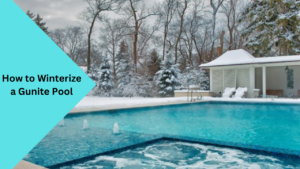Welcome to the ultimate guide on how to winterize a gunite pool. As the colder months approach, it’s crucial to properly protect your investment to ensure it remains in excellent condition for many years to come. In this comprehensive guide, we will take you through the step-by-step process of winterizing your gunite pool, provide valuable insights on the differences between gunite and concrete pools, and answer commonly asked questions about winterizing your pool. Let’s dive in!
- Understanding Gunite Pools: What Makes Them Different
- Why Winterizing Your Gunite Pool is Important
- How to Winterize a Gunite Pool: Step-by-Step Guide
- Can You Drain a Gunite Pool for the Winter? Pros and Cons
- How to Winterize a Concrete Pool: Similarities and Differences
- FAQs About Winterizing Gunite Pools
- Conclusion
Understanding Gunite Pools: What Makes Them Different
Before we delve into the winterization process, it’s essential to understand what sets gunite pools apart from other types of pools. Gunite pools are constructed using a mixture of concrete and sand sprayed onto a framework of rebar. This construction method provides gunite pools with exceptional durability, flexibility, and potential for unique designs.
Why Winterizing Your Gunite Pool is Important
Properly winterizing your gunite pool is crucial for several reasons. Firstly, it protects your pool’s structure from potential freeze-thaw damage by preventing water from expanding and causing cracks. Secondly, winterization prevents damage to vital pool equipment, including pumps, filters, and plumbing. Lastly, proper winterization saves you time and money on repairs and maintenance in the long run.
How to Winterize a Gunite Pool: Step-by-Step Guide
Ensuring that your gunite pool is thoroughly winterized requires a systematic approach. Follow these steps to protect your pool from the winter elements:
Step 1: Clean and Balance the Water Chemistry
Before winterizing your pool, it’s essential to clean it thoroughly, including brushing the walls, vacuuming any debris, and skimming the surface. Additionally, make sure to balance the water chemistry by adjusting pH, alkalinity, and sanitizer levels.
Step 2: Lower the Water Level
To prevent potential freeze damage, it’s crucial to lower the water level in your pool. The specific water level may vary depending on your geographical location, but a general guideline is to lower the water level approximately 12 to 18 inches below the tile line.
Step 3: Remove Equipment and Accessories
Remove any equipment and accessories from your pool, such as ladders, handrails, and diving boards. Clean and store them in a safe and dry location to prevent damage during the winter months.
Step 4: Protect the Plumbing System
To protect the plumbing system from freezing, it’s essential to blow out any water in the pipes using compressed air. This prevents potential damage caused by frozen water expanding inside the pipes. Alternatively, you can use pool antifreeze to safeguard the plumbing system.
Step 5: Add Winterization Chemicals
Add winterization chemicals to your pool according to the manufacturer’s instructions. These chemicals will help maintain water quality and prevent the growth of algae and bacteria during the winter months. To explore more details and considerations regarding Algae, our comprehensive guide on A Complete Guide to Eradicate Mustard Algae: Say Goodbye to Pool Troubles has you covered.
Step 6: Cover the Pool
Invest in a high-quality, properly fitting pool cover to provide an additional layer of protection. Ensure that the cover is tightly secured to prevent leaves, debris, and animals from entering the pool.
Can You Drain a Gunite Pool for the Winter? Pros and Cons
While draining a gunite pool completely is not recommended, there are pros and cons to consider. Draining a gunite pool for the winter can help prevent potential freeze damage and reduce the need for winterization chemicals. However, completely draining a pool can lead to structural problems if the pool is not designed to withstand the pressure of the surrounding groundwater. Consult with a professional to determine if draining your gunite pool is a suitable option for your specific situation.
How to Winterize a Concrete Pool: Similarities and Differences
Winterizing a concrete pool is similar to winterizing a gunite pool due to their comparable construction materials and durability. The steps involved in winterizing a concrete pool are mostly the same, from balancing water chemistry to protecting the plumbing system. However, it’s essential to consider any specific requirements or recommendations from the pool manufacturer or installer. Adjust the steps accordingly to ensure the proper winterization of your concrete pool.
FAQs About Winterizing Gunite Pools
Here are some frequently asked questions about winterizing gunite pools:
Do You Drain a Gunite Pool in the Winter?
While it is not necessary to drain a gunite pool completely for the winter, lowering the water level is recommended to prevent freeze damage. Consult your pool professional for specific guidelines based on your pool’s design and location.
How Far Down Should I Drain My Pool for Winter?
As mentioned earlier, a general guideline is to lower the water level approximately 12 to 18 inches below the tile line. However, specific recommendations may vary based on factors such as climate and the pool’s individual characteristics.
How Do You Seal a Gunite Pool?
To maintain the structural integrity of your gunite pool, regular sealing is essential. Consult with a professional pool company to determine the best sealing options for your specific pool, as different sealants may be recommended based on the age and maintenance history of your pool.
Conclusion
As winter approaches, taking the time to properly winterize your gunite pool is a crucial step in protecting your investment. By following the step-by-step guide outlined in this blog post, you can ensure that your pool remains in excellent condition and is ready for enjoyment when the warmer months return. Remember, proper winterization not only prevents potential damage but also saves you time, money, and headaches down the line. So, take care of your gunite pool today, and thank yourself later!

Greetings, fellow pool enthusiasts! I’m Turner Davis, your dedicated guide to the world of pool care and maintenance. With over a decade of experience in the field, I’ve made it my mission to transform ordinary pools into extraordinary aquatic retreats.

